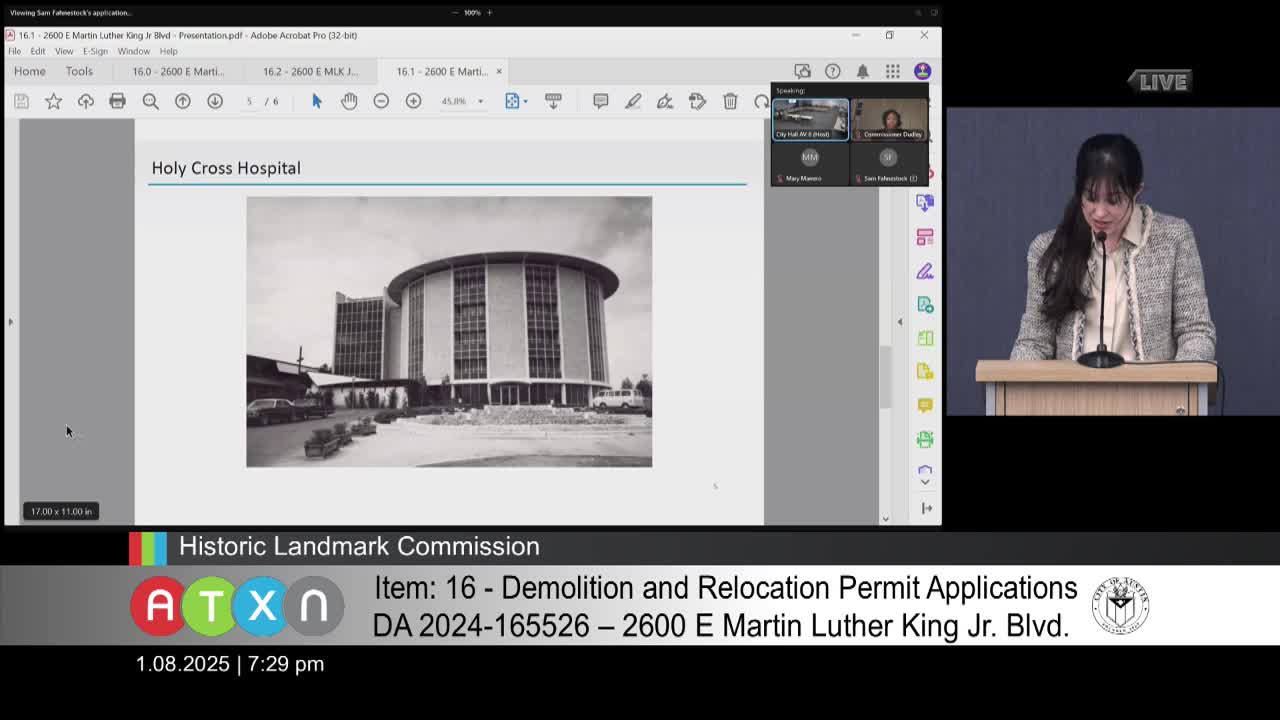Austin's Historic Cancer Center Faces Demolition Amid Plans for Mixed-Use Development
January 08, 2025 | Austin, Travis County, Texas
This article was created by AI summarizing key points discussed. AI makes mistakes, so for full details and context, please refer to the video of the full meeting. Please report any errors so we can fix them. Report an error »

In a recent meeting held at Austin City Hall, discussions centered around the future of a historic building that once served as a cancer and radiation center. The structure, designed in mid-century modern style by Paige Sutherland and Paige, stands vacant today, its integrity compromised by the demolition of its surrounding hospital campus. The site, which is now home to hazardous materials, poses safety concerns for potential reuse.
The building is historically significant, being part of the Holy Cross Hospital system, which was notable for employing African American doctors during the segregation era in Austin. This legacy is memorialized by a state historical marker, emphasizing the site's importance to the cultural identity of the community. The Capital Area Research and Radiation Center, which operated within the building, provided essential healthcare services to Central Texas.
During the meeting, city officials acknowledged the building's historical value while also recognizing the challenges posed by its current condition. The applicant, represented by Leah Bojo from the Jenner Group, presented plans for a mixed-use development on the site. The proposal aims to honor the history of Holy Cross Hospital while addressing the practicalities of the existing structure, which has suffered significant degradation over the years.
Despite the building's historical significance, the Commission expressed comfort in approving the demolition permit, contingent upon the receipt of necessary documentation from the City of Austin. The new design, which incorporates elements reminiscent of the original structure, aims to preserve the memory of the iconic round building that once stood on the site.
As the meeting concluded, the future of the site remains a blend of respect for its past and a vision for its redevelopment, reflecting the ongoing evolution of Austin's landscape and community identity. The discussions highlighted the delicate balance between preserving history and accommodating modern needs, a challenge that many cities face as they grow and change.
The building is historically significant, being part of the Holy Cross Hospital system, which was notable for employing African American doctors during the segregation era in Austin. This legacy is memorialized by a state historical marker, emphasizing the site's importance to the cultural identity of the community. The Capital Area Research and Radiation Center, which operated within the building, provided essential healthcare services to Central Texas.
During the meeting, city officials acknowledged the building's historical value while also recognizing the challenges posed by its current condition. The applicant, represented by Leah Bojo from the Jenner Group, presented plans for a mixed-use development on the site. The proposal aims to honor the history of Holy Cross Hospital while addressing the practicalities of the existing structure, which has suffered significant degradation over the years.
Despite the building's historical significance, the Commission expressed comfort in approving the demolition permit, contingent upon the receipt of necessary documentation from the City of Austin. The new design, which incorporates elements reminiscent of the original structure, aims to preserve the memory of the iconic round building that once stood on the site.
As the meeting concluded, the future of the site remains a blend of respect for its past and a vision for its redevelopment, reflecting the ongoing evolution of Austin's landscape and community identity. The discussions highlighted the delicate balance between preserving history and accommodating modern needs, a challenge that many cities face as they grow and change.
View full meeting
This article is based on a recent meeting—watch the full video and explore the complete transcript for deeper insights into the discussion.
View full meeting
